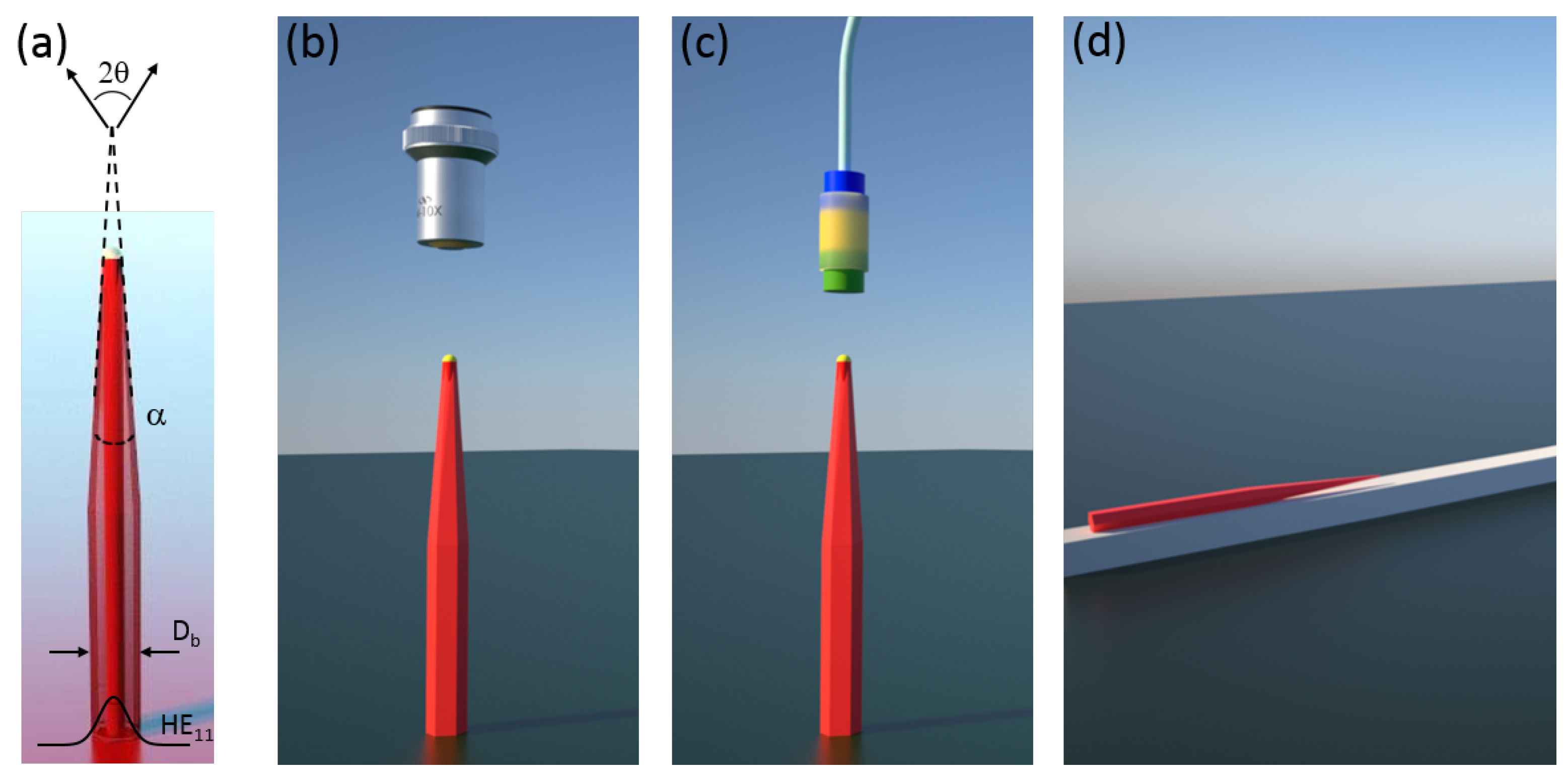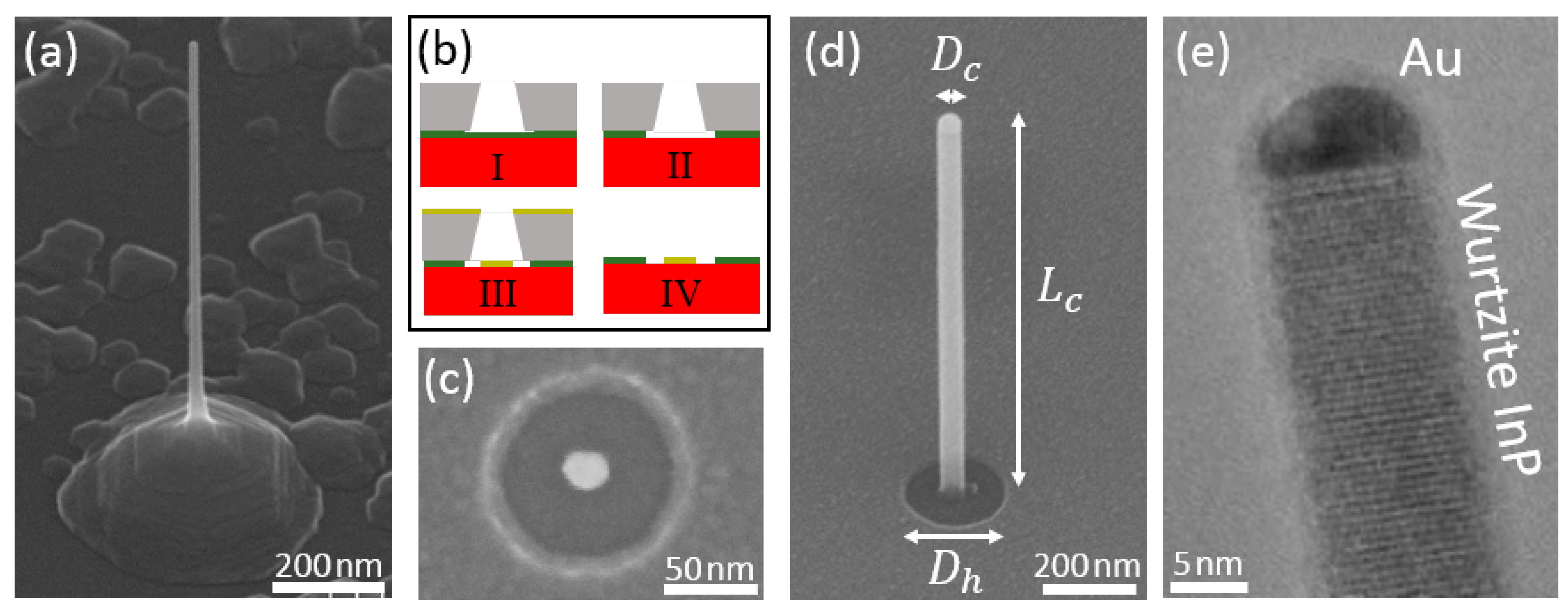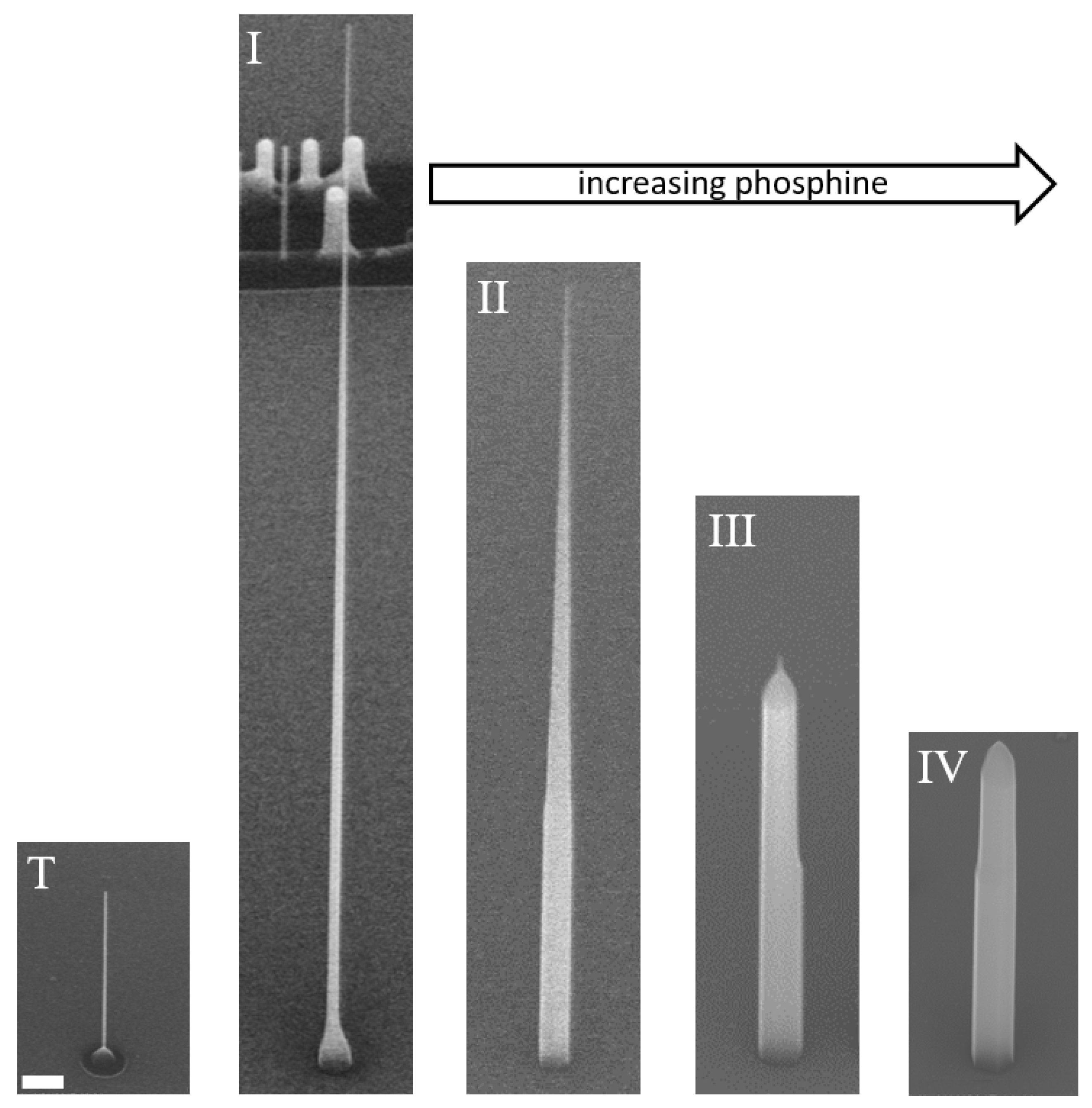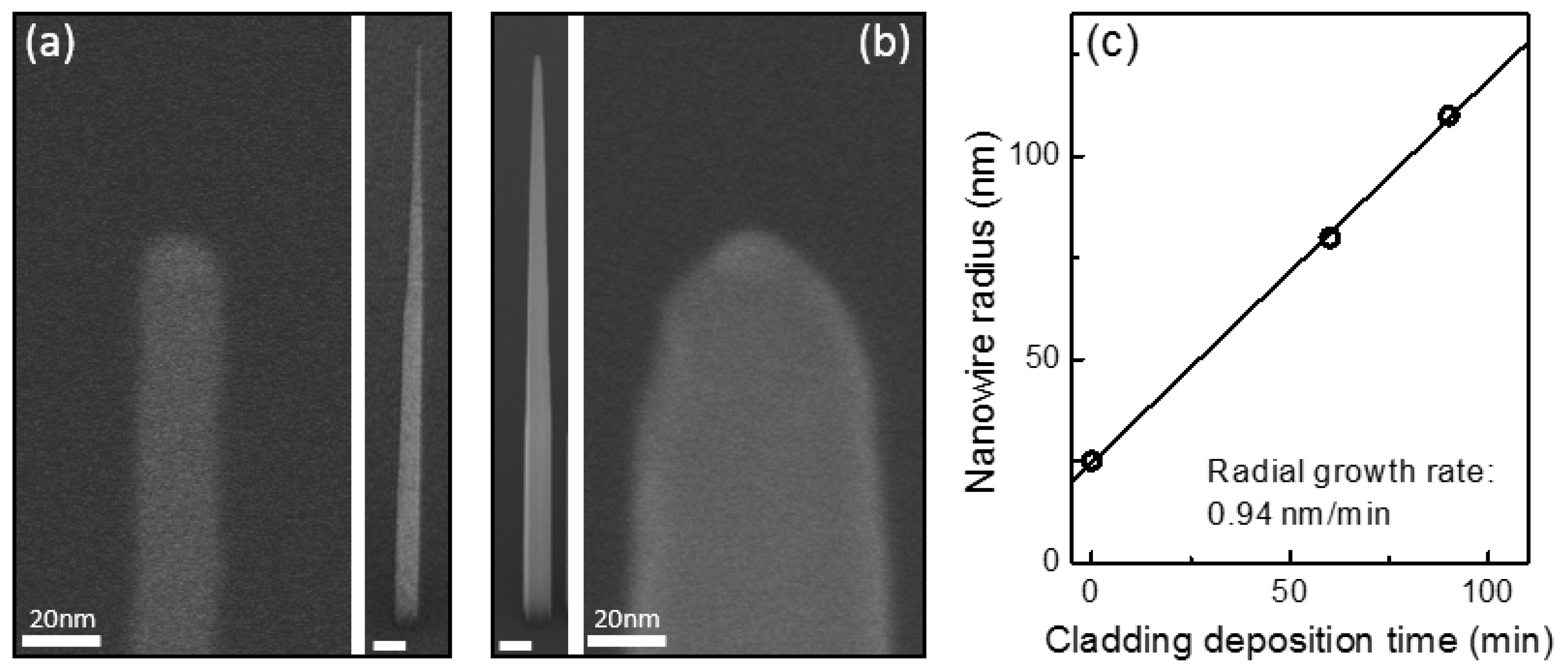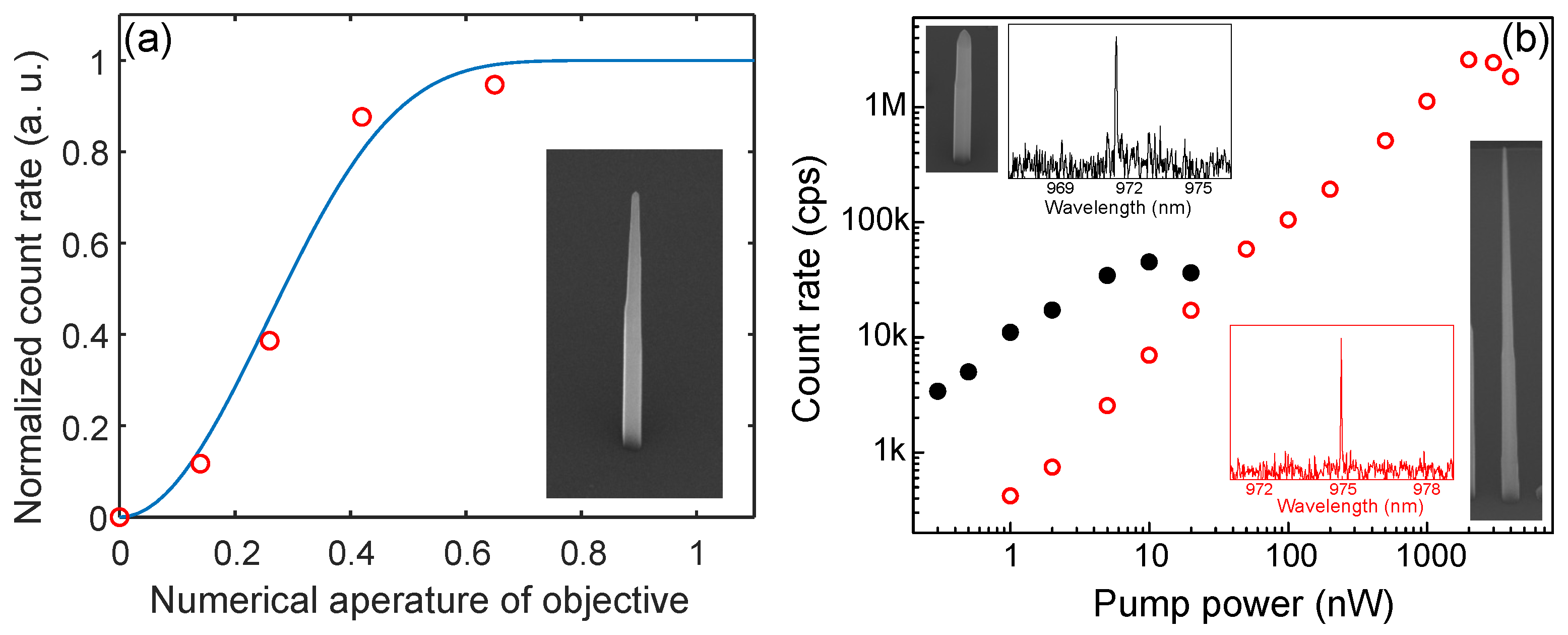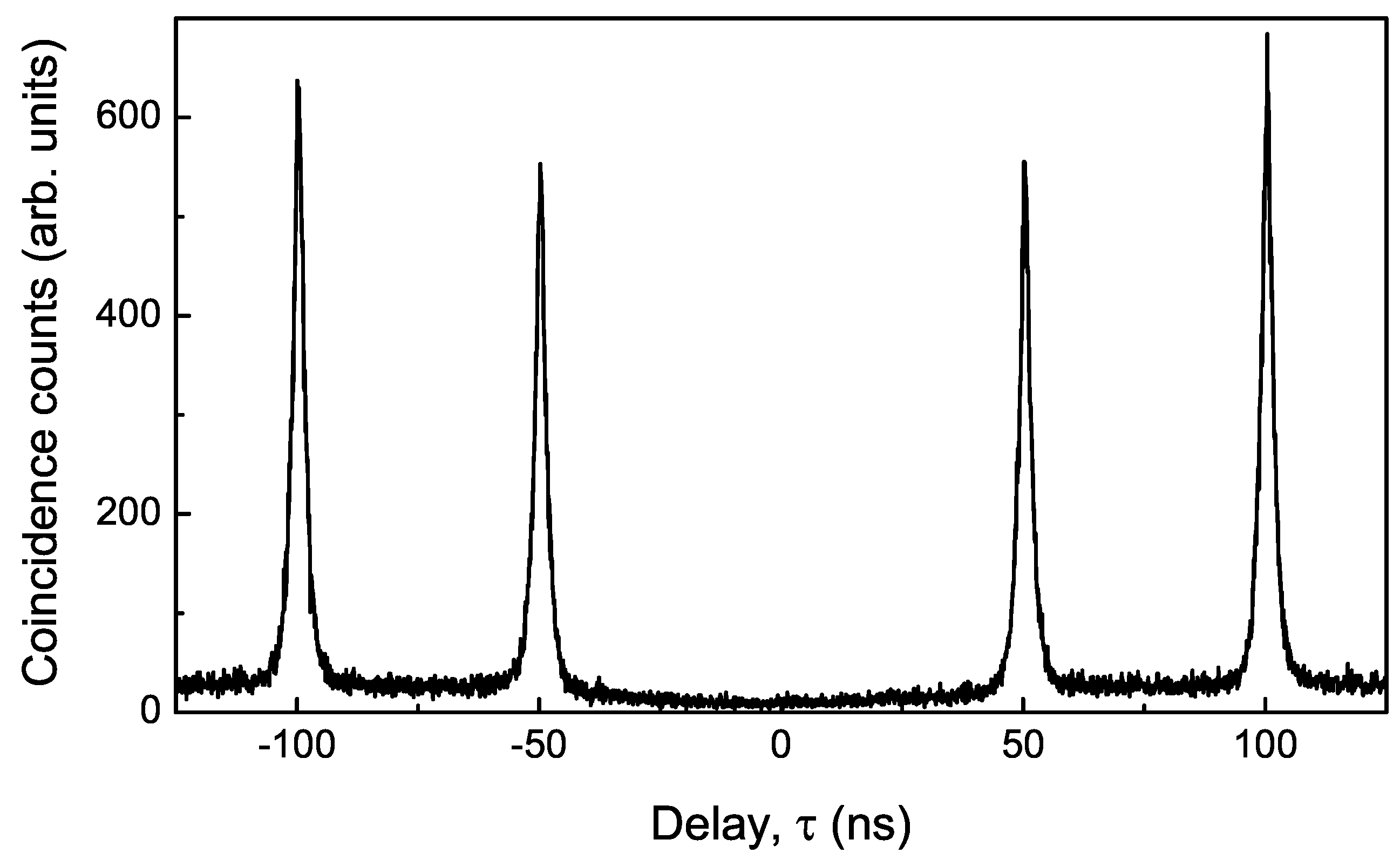The shape of the grown nanowires can be understood through an appreciation of the relative incorporation rates/diffusion lengths of the group III species (indium in our case) on the different crystal surfaces. The surfaces of importance here are:
The final geometry of the nanowire is determined by the competition between incorporation on these different surfaces, which can be controlled by the growth conditions used. To grow the nanowire core the conditions are chosen to have a very high incorporation rate at the Au/InP interface and low incorporation rate on the nanowire sidewall (by having a long diffusion length). This means that indium deposited on the sidewall will preferentially diffuse to, and incorporate at, the Au/InP interface or the substrate surface surrounding the nanowire. This results in the structure shown in
Figure 3 where an untapered nanowire is shown with a pedestal at the base. When the nanowire becomes significantly longer than the diffusion length of In on the sidewall, typically a few microns, then radial growth and tapering is observed, see image I in
Figure 4. If, on the other hand, the incorporation rate at the Au/InP interface can be suppressed relative to that on the sidewall, a radial growth mode can be encouraged. By controlling the relative axial to radial growth rates the geometry of the final nanowire can be engineered.
3.1. Group V Flux
In this section we study the role of the Group V flux on the nanowire geometry. Four samples were grown (I, II, III, IV) in which the same growth conditions were used for the nanowire template but different PH
fluxes during growth of the shell. The growth conditions used are shown in
Table 1. The templates were prepared using a 12 to 16 s oxide mask wet-etch for hole sizes of
nm and 5 nm of deposited gold for a catalyst diameter of
nm. The template nanowire growth step was carried out at a temperature of 435 °C using a flow rate,
sccm for PH
3 which are the conditions that promote VLS growth. The growth time was 23 min corresponding to a planar equivalent growth thickness
nm determined from calibration growths on (100) substrates at 500 °C. These growth conditions produce
μm long untapered template nanowires such as the one shown in image T of
Figure 4.
Sample I was clad using the same growth conditions that were used to grow the nanowire template with an additional planar equivalent growth thickness
nm of InP deposited using a PH
3 flow rate of
sccm. Here we define cladding as any material deposited after the growth of the template nanowire. The resulting nanowire, shown in image I of
Figure 4, has a small pedestal at the base and then tapers from 60 nm to 20 nm over a length of 10.7 μm. This geometry is expected when material incorporation occurs primarily at the metal/semiconductor interface and the substrate surface rather than the nanowire sidewall. As mentioned above, growth of the nanowire template is carried out under conditions that promote this VLS growth. As the nanowire becomes longer than the In adatom migration length on the sidewall a slight taper is developed as material incorporates on the sidewalls prior to reaching the metal/semiconductor interface or the substrate. The pedestal at the base will typically grow to fill in the opening in the oxide mask and then increase in height with vertical sidewalls through preferential incorporation at the step edges at the top of the pedestal [
18].
Images II through IV of
Figure 4 show the effect of the Group V flux used during cladding deposition. For these growths, the cladding temperature was slightly higher, 450° compared to 435°, which does not significantly alter the nanowire geometry [
12]. Image II shows the resulting nanowire geometry when the cladding is deposited with a PH
3 flow rate of
sccm. The nanowire is shorter, even though an additional
nm of cladding material was deposited (see
Table 1). The top still tapers to 20 nm but over a shorter length. Tapering is a direct consequence of simultaneous radial and axial growth, and the ratio between the two will determine the taper angle, the larger the ratio the larger the angle. This change in relative incorporation rate results from a reduction of the incorporation rate at the metal/semiconductor interface and a reduced In adatom migration length on the sidewall. A taper also results in a high density of step edges which further reduces the diffusion length of indium on the sidewalls. The pedestal at the base is replaced by an untapered base section with diameter
(e.g., the diameter of the nanowire has filled in the opening in the oxide mask). The diffusion length on the untapered sidewall section (
or
facets) is still long enough for material to reach and incorporate at the tapered section which allows the base diameter to be constrained by the oxide mask.
Increasing the PH
3 flow rate further (and consequently reducing the axial growth rate) results in even shorter nanowires until the untapered base makes up the entirety of the nanowire, as in images III and IV in
Figure 4. At this point growth is dominated by incorporation directly on the
or
facets that form the sidewalls of the nanowire as well as the steps which are now located at the nanowire tip. Under these conditions, the nanowire is no longer constrained by the oxide mask and the diameter can exceed
. We also note that the gold catalyst no longer seems to play any significant role in the growth dynamics, a similar result is observed when using high growth temperatures [
12]. The above results are summarised in
Table 1.
This PH
3 flux-meditated control of the relative incorporation rates can be used to fine tune the nanowire geometry using a multi-step cladding process. For example, in
Figure 5a we show a nanowire clad as in sample II but using a shorter template nanowire (
nm,
μm). The nanowire has a base diameter of 200 nm, a tip diameter 20 nm and a height of 7.7 μm, very similar to that in image II of
Figure 4 but slightly shorter.
Figure 5b shows the nanowire geometry obtained if an additional
nm is then deposited at a higher PH
3 flux (e.g., the growth conditions used to clad sample IV). The resulting nanowire has a similar height (7.2 μm) but the diameter has increased almost uniformly along its length, to
nm at the base and
nm at the tip. This demonstrates that a PH
3 flow rate of 15 sccm produces pure radial growth. By measuring the nanowire diameter as a function of the growth time of the second cladding, we calculate a radial growth rate of ∼1 nm/min, see
Figure 5c under these conditions.
3.2. Template Geometry
The structure of the photonic nanowire may be further manipulated depending on the detailed geometry of the initial nanowire template. In the following we consider the influence of the template geometry, in particular the template nanowire height, , and catalyst diameter, , as well as the size of the opening in the oxide mask, , in determining the geometry of the photonic nanowire.
We discuss first the influence of the diameter of the oxide opening,
. The size of the opening allows one to control the base diameter of the photonic nanowire. This diameter is crucial in designing photonic nanowires that provide optimal overlap between embedded emitters and guided optical modes in the nanowire [
16]. The required diameter,
D, will depend on the emission wavelength of the emitter,
, according to
[
16]. Although
can be readily controlled using wet-etch time [
19], to obtain a corresponding photonic nanowire diameter
D over a sufficiently long section of the nanowire to adequately confine the desired optical mode requires optimisation of the growth conditions used in the cladding process.
As an example,
Figure 6a shows a nanowire clad as in sample II but grown on a mask prepared using a 20 s oxide etch. The geometry of the nanowire is very similar to that shown in image II of
Figure 4 but with a slightly larger base diameter of 230 nm. Repeating the growth on a mask prepared using a 24 s oxide etch produces the nanowire shown in
Figure 6b. Although the base diameter has increased to 325 nm, this only extends a few hundred nanometers above the substrate, after which the diameter abruptly decreases to 195 nm then tapers to 20 nm over the length of the nanowire. As shown in
Section 3.1, the cladding process is not simply related to the adatom migration lengths but also requires consideration of preferential incorporation at step edges produced at the base of the nanowire due to substrate growth in the annulus of exposed InP. To obtain a more uniform taper in a nanowire having a large base diameter simply requires additional material deposition at an appropriate PH
3 flux. This is shown in
Figure 6c where an additional
nm of InP was deposited on a structure as in
Figure 6b using
sccm.
We consider next the role of the height
and diameter
of the template nanowire in determining the photonic nanowire geometry. When growing using a low group V flux there is a strong dependence of the axial growth rate on catalyst diameter,
, due to geometric effects on the collection of In in the catalyst [
12]. This means that the nanowire height,
, will depend not only on the amount of material deposited but also on
. Specifically, increasing the catalyst diameter produces shorter nanowires. In that using a different value for
simply results in a nanowire with a different height, the role of the nanowire template diameter on the photonic nanowire geometry is the same as that of
.
In what follows we highlight the effect of
D, and hence
, on the nanowire taper when using growth conditions targeting tapered geometries similar to sample II in
Figure 4. We use a 12 s oxide mask etch and a
nm template growth step at 420 °C followed by a
nm cladding growth step using
sccm. To obtain template nanowires with different diameters, we pattern a linear array of holes in the electron-beam resist (step I in
Figure 2b), incrementally increasing the hole size by increasing the electron-beam dose. The increments are adjusted to produces an increase of 2 nm in the catalyst diameter after lift-off (step IV in
Figure 2b).
The resulting linear array of nanowires is shown in
Figure 7. The nanowires are uniformly tapered with base diameters
defined by
and tip diameters
defined by the catalyst diameter, which increases from 20 nm (left) to 38 nm (right). The dominant effect of decreasing
(i.e., increasing
) is a reduction of the nanowire taper
where
is the taper length. This is quantified in the inset of the figure which shows the calculated taper angle
as a function of the template nanowire diameter. This behaviour is a direct consequence of the taper angle dependence on the ratio of axial to radial growth rates. Decreasing the axial growth rate by increasing the Au particle diameter causes an increase in the taper angle.
3.3. Optical Characterization
The main incentive for controlling the taper of the photonic nanowire is to reduce the far-field emission angle of the guided optical mode via its gradual expansion. To gain insight into how the emission profile can be manipulated by tailoring the nanowire geometry, we calculate the far-field radiation pattern for different nanowire tapers. Simulations of the HE mode propagation along the nanowire taper were performed using finite difference time domain methods and the calculated electric field distribution was transformed into the far-field to analyze the numerical aperture S of the nanowire source.
Figure 8 shows the calculated dependence of S
on the taper parameters
,
and
defined in
Figure 1a. The simulations were performed with
nm and
nm. In
Figure 8a we show the effect of the taper length
on the far-field for a fixed taper angle
. In this case, the tip diameter
also varies, necessarily decreasing as
increases in order to maintain a fixed
, illustrated schematically by the insets. The figure shows four data sets, each set corresponding to the dependence of S
on
for tapers with a different
. For small values of the taper length, S
tends to one, indicating a strongly diverging beam that is unsuitable for coupling to collection optics. As the taper length increase, S
is initially insensitive to the changing length, indicating that the HE
mode is still well confined, but then eventually starts to diminish. The taper length at which S
starts to drop increases with decreasing
, since the nanowire diameter at which the HE
mode is not well confined is reached at longer taper lengths for smaller taper angles. For sufficiently long tapers and small taper angles, arbitrarily low values of S
can be achieved.
In
Figure 8b we show the variation of S
with increasing taper length
for a fixed tip diameter
(i.e., truncated tapers). Since fixing the diameter necessarily reduces
as
is increased, the observed trend is consistent with
Figure 8a i.e., long tapers and low taper angles produce low S
values. Finally, in
Figure 8c, we show the dependence of S
on the diameter of the nanowire tip,
, for a fixed taper length of
μm. In this case, a minimum S
is observed at a tip diameter
of approximately 0.12 μm, corresponding to a taper angle
of approximately 0.19°. This minimum in the numerical aperture that can be achieved is somewhat surprising at first glance, but the phenomenon is seen clearly in
Figure 8a also, where a nanowire of taper length
μm has a smaller S
for a 0.25° taper angle than for 0.125° or 0.5°.
To compare with experiment, we use a quantum dot, embedded near the base of the nanowire, to populate the HE
mode [
20]. The dot is incorporated by switching from PH
to AsH
for 3 s during the growth of the template nanowire to produce an InAs
xP
section ∼5 nm thick with
. The photoluminescence from the dot is measured at 4 K in a closed-cycle He cryostat using a grating spectrometer and a liquid nitrogen-cooled CCD. Using the growth conditions above produces dots with exciton photon emission around
nm.
A rigorous determination of the angular emission distribution requires measurement of the 3D far-field profile, using for example, Fourier microscopy techniques [
21]. One can also estimate the divergence of the mode from the dependence of the emitted photon count rate on the NA of the objective used for collection.
Figure 9a shows the photoluminescence counts from exciton recombination in the dot collected using different NA objectives. For each objective, the excitation power was adjusted to saturate the count rate of the exciton photons, in this manner guaranteeing that the excitation rates were identical. To estimate the divergence of the emitted beam, we model the system as a Gaussian mode and calculate the collection rate as a function of angle, neglecting any reflection that may occur from the nanowire tip, see Ref. [
9]. In
Figure 9a, the best fit to the data gives S
. For this nanowire geometry (
μm,
, see inset in the figure) the estimated value of S
is consistent with the calculations of
Figure 8a.
The impact of the nanowire geometry on the collection efficiency is demonstrated in
Figure 9b where we compare the count rates from quantum dots embedded in two extreme nanowire geometries. In one device, the dot is incorporated in short nanowire with a truncated taper (top-left inset of the figure) whilst in the second device, the nanowire is optimised for low S
with a long, nearly conical taper (bottom-right inset). In particular, the former structure has a taper length of
μm and taper angle of
for which an
approaching 1 is predicted, whilst for the later,
μm and
for a predicted
. For both devices, the quantum dots have exciton photon emission around
nm (see insets) and are incorporated within nanowires having similar base diameters
nm, hence comparison of the count rate at saturation is a measure of the relative collection efficiency between the two devices. Using an objective with
, the count rate from the optimised structure is 57 times brighter compared to the unoptimised device. This indicates that a significant fraction of the emitted beam from the latter device is directed at angles larger than the acceptance angle of the collection objective (
24.8°), consistent with the high NA of the source.
Finally, we demonstrate an on-demand single photon source based on a single quantum dot embedded in a photonic nanowire having a geometry optimised for high collection efficiency. We use the photonic nanowire structure shown in the bottom-right inset of
Figure 9b, which was previously employed to demonstrate 43% collection efficiency [
22]. This source efficiency is obtained without the use of a back mirror meaning that 86% of the photons directed towards the taper are collected. To verify single photon operation, a use a Hanbury Brown and Twiss setup. We measure the temporal correlation of emitted exciton photons using pulsed above-band excitation at a repetition rate of 20 MHz. Exciton photons are first filtered and then split into two beams to be measured by two single photon detectors. The arrival time at each detector is register using counting electronics to build a histogram of the delay times between detection events on the first and second detector,
.
A histogram of the raw coincidence counts is shown in
Figure 10 where negligible counts are observed at a delay time
. The complete absence of the zero delay peak is a signature of high purity single photon emission i.e., for each excitation pulse, one and only one exciton photon is emitted. The negligible probability of observing multi-photon emission events is a consequence of using a structure that contains one and only one quantum emitter. This is in contrast to devices employing ensembles of randomly nucleated dots which may suffer spectral pollution from nearby quantum dots, requiring the use of resonant pumping techniques and/or cavity structures [
3] to reach similar levels of single photon purity.
